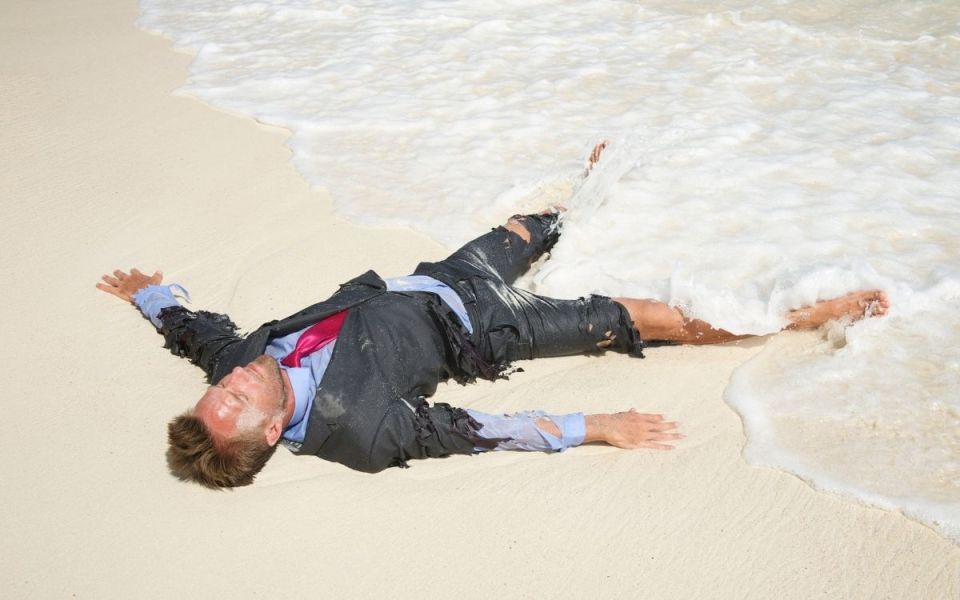Dehydration Isn’t a Day at the Beach

In the original Pirates of the Caribbean (The Curse of the Black Pearl), there comes a time when Jack Sparrow and Elizabeth Swann are marooned on a desert island with naught but a single bullet between them. Luckily, it turns out, the island is stocked with rum, which Elizabeth sets ablaze as a signal for rescue. This is probably the best use of the rum, as consuming alcohol exacerbates the most dangerous condition on a desert island: other pirates dehydration.
Dehydration is when your body loses more water than it takes in. The average adult loses up to three liters of water per day passively through skin evaporation, breathing, sweating, and going to the bathroom.[1] Exercise can increase this loss by up to two liters per hour.[1] Our minimum daily water requirements were initially estimated from studying castaways (like Jack and Elizabeth).[1] Generally, adults need somewhere between 2 and 3.7 liters (roughly ½ to 1 gallon) of water per day, with men typically needing more than women.[2,3] Age and some neurological disorders lower our thirst sensation, which can lead to decreased water intake.[4] We get around 75-80% of our daily water intake from drinking fluids, with the rest from the water content in the foods we eat.[2,3]
Our body’s water contains dissolved minerals that are electrically charged and known as electrolytes. It is important for the body to maintain a proper balance of these electrolytes in its fluids to support normal bodily functions.[1] The electrolytes most involved with dehydration are sodium and chloride, commonly found together as table salt (NaCl). These electrolytes also act like pirates, hijacking water from areas where the concentration of electrolytes is low to areas where it is high, balancing the concentrations across cell membranes.[1] It works through a process called osmosis.
(Left) A balloon with a high salt concentration is placed in a bath of distilled water.
(Right) The water flows into the balloon, causing it to inflate.
Our bodies are around 55-65% water, with lower water percentages in older people and those with obesity.[1,2,3,4] Around ⅔ of the body’s water is found inside individual cells (intracellular water), with the rest in places like blood, spinal cord, muscle, and other tissue (extracellular water).[4] A loss of about 2% of body weight due to water indicates dehydration.[1] Water loss comes from four main areas: excessive fluid loss, reduced fluid intake, internal problems like sepsis or cirrhosis, and medications.[3,4] Not all water loss is the same, however, and the amount of salt lost determines the character of dehydration.
Intracellular dehydration is when we lose water without losing a significant amount of the dissolved electrolytes.[1] It is also called dehydration with minimal salt loss or hypertonic dehydration.[1,3,4] Major ways to lose water without losing salt are through excess sweating, excess urination, diabetes, and not drinking enough water.[1,4] This is what would have happened to Jack and Elizabeth in a few days if they weren’t rescued from marooning.
Intracellular dehydration leaves a plethora of salt in the blood, which commandeers water out of cells.[4] To fight this, the kidneys retain water, and neurological signals trigger thirst.[1] Extreme intracellular dehydration pulls water from brain cells, causing delirium, confusion, seizures, coma, and possibly death.[4]
Extracellular dehydration occurs when water and salt are lost in roughly equal proportions.[1] It may also be called isotonic dehydration or volume depletion.[1,4] If Jack and Elizabeth had drunk all the rum on the island, the inevitable vomiting would lead to extracellular dehydration. Other causes of extracellular dehydration include diarrhea, hemorrhage (blood loss), hypoxia (low oxygen), and certain medications.[1,4] Interestingly, being in fresh water for extended periods of time can also cause extracellular dehydration, so if Jack and Elizabeth had walked the plank over a swimming pool instead of the ocean, they may have become extracellularly dehydrated anyway.[1]
With extracellular dehydration, water can’t be taken from the cells using osmosis.[1] The body reacts by shrinking the blood vessels in a process called vasoconstriction.[1,4] The body also slows the replenishment of blood, retains water in the liver, and sends signals to increase thirst.[1] Extreme extracellular dehydration results in a drop in blood volume, causing blood pressure and heart output to fall.[4] In response, the heart may compensate by beating extremely fast, a condition known as tachycardia.[4]
Symptoms of dehydration include headache, fatigue, apathy, and thirst.[1] Higher levels of dehydration can result in muscle cramps, weakness, neurological changes, and heart problems.[1,4] Long-term dehydration causes problems with the systems that manage water regulation, including the kidneys.[4] Luckily, the solution for mild and moderate dehydration is simple: drink water! As we now know, however, you may need more than just water! Intracellular dehydration may be relieved with regular tap water, but extracellular dehydration requires electrolytes, which is why warm chicken soup (full of salt!) is so helpful after vomiting and diarrhea. Severe dehydration is responsible for 1-3% of hospitalizations and requires fluids delivered intravenously. Overall, dehydration isn’t a day at the beach, so remember to hydrate.
Creative Director Benton Lowey-Ball, BS, BFA
|
Click Below for ENCORE Research Group's Enrolling Studies |
|
Click Below for Flourish Research's Enrolling Studies |
References:
[1] Cheuvront, S. N., & Kenefick, R. W. (2014). Dehydration: physiology, assessment, and performance effects. Comprehensive physiology, 4(1), 257-285. https://onlinelibrary.wiley.com/doi/full/10.1002/j.2040-4603.2014.tb00543.x
[2] Standing Committee on the Scientific Evaluation of Dietary Reference Intakes, Panel on Dietary Reference Intakes for Electrolytes, & Water. (2005). Dietary reference intakes for water, potassium, sodium, chloride, and sulfate. National Academies Press.
[3] Puga, A. M., Lopez-Oliva, S., Trives, C., Partearroyo, T., & Varela-Moreiras, G. (2019). Effects of drugs and excipients on hydration status. Nutrients, 11(3), 669. https://www.mdpi.com/2072-6643/11/3/669
[4] Taylor, K., Tripathi, A. K., & Jones, E. B. (2025). Adult dehydration. In StatPearls [Internet]. StatPearls Publishing. https://www.ncbi.nlm.nih.gov/books/NBK555956/



